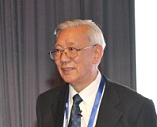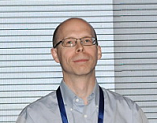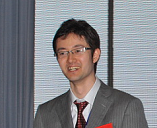
ACFA/IPAC13 Accelerator Prize
The ACFA / IPAC'13 Accelerator Prize Award Ceremony was held during the IPAC'13 in Shanghai in May 2013.

Image of the prize award ceremony at the IPAC'13. Seen in the photograph
are: the Prize winners and
the Prize presenters (the Chairman of the Prizes Selection Committee, the
IPAC13 Chair and the ACFA Chair)
Photo Credit: IPAC13
For more ceremony images, please visit the IPAC'13 Official Website (Photo Gallery).
| PRIZE | AWARDEE | DESCRIPTION |
|---|---|---|
Prize a) |
 Professor Shouxian Fang, |
The prize, for outstanding work in the accelerator field with no age limit, is awarded to Professor Shouxian Fang. Professor Fang has contributed to accelerator physics and technology throughout his whole scientific career. He in particular led the team constructing the Beijing Electron-Positron Collider (BEPC), the first high energy accelerator in China, opening up accelerator-based experimental high-energy physics research, leading to the modernization of scientific research in China. He later contributed to initiating the major upgrade of BEPC (BEPCII), the Shanghai Synchrotron Radiation Facility (SSRF), the China Spallation Neutron Source (CSNS), the Chinese Accelerator Driven Subcritical System for nuclear waste transmutation (CADS) as well as proton therapy accelerators in China. He has promoted accelerator-based science in China through extensive international collaboration worldwide and built-up a solid bridge between China and other parts of the world in the accelerator field. |
Prize b) |
 Dr. Michael Borland, |
The prize, for an individual, having made a recent significant, original contribution to the accelerator field with no age limit, is awarded Dr. Michael Borland for his original contributions in creating the ELEGANT program and its SDDS (Self Describing Data Sets) platform that are widely applied in design, simulation, and analysis of circular accelerators, ERLs and FELs. Using ELEGANT, he predicted for the first time the CSR-driven microbunching instability in LCLS, which was eventually experimentally verified, and this discovery triggered an active on-going field of research. Along with the development of simulating start-to-end jitter in LCLS, the first of such attempts, Borland also co-developed program toolkits used in the control systems applications for accelerators. His algorithms, methods and software have been widely adopted by accelerator facilities, in particular APS, BESSY, ELETTRA, LCLS, LHC, NSRRC, RHIC, SPring-8 and TJNAF, for numerous developments in the field of beam dynamics and non-linear optimizations |
Prize c) |
 Dr. Hiroshi Imao, |
The prize, for an individual in the early part of his or her career, having made a recent significant, original contribution to the field, is awarded to Dr. Hiroshi Imao, for the realization of the next-generation charge-state stripper using recirculating helium gas.This stripper is characterized by its infinite lifetime, efficient stripping, and small beam degradation even for the most intense uranium ion beams and has made it possible to increase the intensity of uranium ion beams by an order of magnitude at RIKEN’s RIBF, providing an immeasurable impact on the field of heavy-ion accelerators worldwide, such as the FAIR at GSI, FRIB at MSU/ANL, and RHIC at BNL. Hiroshi Imao also developed an exceptionally compact and efficient positron accumulator that has led to the successful production of anti-hydrogen atoms in the ASACUSA collaboration at CERN |